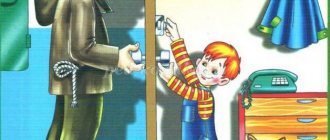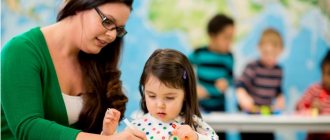Pedagogical technologies in environmental education of preschool children
The technology of organizing labor in nature is carried out in the logic of organizing the work activities of children - from familiarization with the work of an adult in caring for animals and plants to learning feasible methods of care and independent implementation of work activities in nature.
A characteristic feature of work in nature is the focus on helping a living creature or natural object, and therefore the child’s responsibility for the condition of the plant or animal in the process of care increases.
In work activity, the emphasis shifts from activities for oneself (“I water the plant so that it is beautiful and makes me happy”) to activities for another living being (“I water the plant - it needs my help”).
Most children are interested in activities in nature in which they can realize their need to communicate with living objects. For older preschoolers who have a fairly broad understanding of nature, experience interacting with it, and a high level of development of manual skills, practical activities with natural objects are quite interesting and attractive. Many children prefer it to other types of children's activities. Currently, the values of labor, including labor caring for animals and plants, are becoming expressed, and the need for basic labor activity is emerging, which children clearly lack today. Therefore, in kindergarten it is necessary to create conditions to satisfy this need and at the same time develop the practical skills of older preschoolers.
GAMING TECHNOLOGIES
An important role in children’s knowledge of natural objects is played by practical modeling actions, when the teacher depicts with his hands the shape, size, height or length of natural objects: he “draws” a round tomato, an apple, a long carrot, a large round watermelon or a head of cabbage in the air. Asks the children to do the same with their hands - movements and actions reinforce what the eyes see and what is indicated by the word.
The teacher carefully introduces the game as a method of environmental education. At this age, story play is just beginning, it is not yet the leading activity, so the teacher’s task is to select simple and familiar images, play actions and words through which the environmental content will be expressed. The best images for this purpose are the images of the fairy tales “Ryaba Hen”, “Turnip”, “Kolobok”, “The Wolf and the Seven Little Goats”, “Zayushkina’s Hut”.
The theme of domestic animals is easy to imagine with the help of Baba and Grandfather from “Ryaba the Chicken”, who, in addition to chickens, have a cow, a goat, a horse and other animals. Either Grandfather or Baba “comes” to classes, they talk about a cow with a calf, then about a goat with kids, show how they feed them with grass, hay, and water. The teacher gives the children the opportunity to participate in these operations as assistants - they feed toy (or depicted in the picture) cows and goats with hay, graze them, build barns for them, and imitate their actions and sounds. This game allows children to explore rural reality, develops their gaming skills, imagination, and consolidates their knowledge of fairy tales.
Innovative technologies for environmental education of preschool children in the context of the implementation of the Federal State Educational Standard in preschool educational institutions.”
Innovative technologies for environmental education of preschool children in the context of the implementation of the Federal State Educational Standard in preschool educational institutions.”
Environmental education is one of the components of a holistic pedagogical process. Therefore, when planning tasks for environmental activities with preschoolers, you need to pay attention to setting not only educational, but also educational and developmental goals. At the same time, the tasks should cover all areas of work with preschoolers: intellectual development, moral, ethical, aesthetic education, development of hard work, etc.
Our task
– teach the child to treat every living organism as a valuable, unique entity that has the right to life. The best result can be achieved if you begin to form the foundations of environmental culture in preschool age. The main goal of environmental education is to form in children a holistic view of nature and man’s place in it, environmental literacy, and the ability to love the world around them and treat it with care.
The objectives of environmental education for preschoolers are: to develop a conscious understanding of the interconnections of all living and nonliving things in nature; to develop skills in caring for plants and animals, to cultivate children’s sensory and emotional reactions to the environment, and a caring attitude towards nature through targeted communication with the environment.
1. Development and correction of the emotional sphere of children through the organization of direct communication with living nature and the widespread use of psychological and pedagogical games-trainings of natural history content in various types of activities of preschool children.
2. Formation of the basic foundations of environmental culture in children:
- mastering basic ecological knowledge about the nature of the native land, reflecting the connection of living organisms with their habitat;
— obtaining initial understanding and practical skills in the field of environmental management (economic impacts on nature), nature conservation;
— obtaining initial ideas about man as a living organism, about human ecology (understanding of individual manifestations of the dependence of the health of children and adults on the environmental conditions in which they live);
- nurturing in children a positive, active attitude towards objects and natural phenomena with which they come into contact.
3. Disclosure and development of the creative, spiritual and moral potential of each child in the process of communicating with the nature of their native land.
Problem
environmental education is sufficiently covered in various methodological recommendations. Much attention is paid to the use of innovative forms and methods of working with preschoolers.
Innovative processes at the present stage of social development primarily affect the preschool education system, as a level of general education for the development of a child’s potential abilities. Pedagogical innovation represents a purposeful change that introduces stable elements of innovation into the educational space environment, improving the characteristics of individual parts, components and the educational system itself as a whole. The development of preschool education and the transition to a new qualitative level cannot be carried out without the development of innovative technologies.
Innovative technologies have received their new development in environmental education, since the nature of environmental knowledge determines not only various forms of border integration of related subjects, but also the integration of various areas of education and training of preschool children. The content of the educational program of preschool education should reflect aspects of the educational environment for the child: the subject-spatial developmental ecological environment, the nature of interaction with the child, the nature of interaction with other children, the child’s system of relationships to the world, to other people, to himself.
Transformation of the developing subject-spatial ecological environment in accordance with the Federal State Educational Standard for preschool education. Development of mechanisms and tools for the implementation of the Federal State Educational Standard of preschool education, contributing to increasing the level of professional competence of teachers in the field of environmental education in their professional activities. Introduction of new forms of cooperation with parents, the social environment, using the resource of information support for subjects of the educational process, the principles of the event approach. These areas of environmental education are successfully implemented through innovative types of educational technologies, such as:
Game activity.
Role-playing is a method in which children act out a life situation (really occurring or simulated). The game scenario is not described, but only the situation is given. Children model their own behavior and build relationships. In role-playing games, the child’s social competencies are actively formed. Role-playing turns learning into a creative laboratory for self-education.
Games for children are a way of understanding the environment, a path to understanding the world in which they live and which they can change and transform.
The content of role-playing games is given an ecological character.
Puzzle games, experimental games, research games, meditation games give new impressions about the life and work of people, about the state of nature and its changes; awaken interest in nature and develop a value-based attitude towards it; form motives and practical skills for environmentally appropriate activities; provide opportunities for independence, initiative, cooperation, responsibility and the ability to make good decisions.
Case technologies
A technology case is an analysis of a situation or a specific case, a business game. Its main purpose is to develop the ability to analyze various problems and find their solutions, as well as the ability to work with information.
- intended for the development of communicative competencies in those educational areas where there is no clear answer to the question posed, but there are several answers that can compete in terms of truth;
— development of the child in joint activities between child and adult on equal terms. For example, a case photo or a case illustration “Does a child behave correctly in nature?” Discussion method “Good-bad”, “Why did the leaf turn yellow?” or “Why do willows have big buds and birches have small ones?” etc. — the purpose of such a case is to work together with a mini-group of children to analyze the situation, find a way out, the correct version. Computer technologies and multimedia presentations. Information and computer technologies are firmly integrated into the preschool education system and are widely used to improve and update the forms and methods of working with children.
Unlike an adult, for whom it is enough to listen to an oral explanation, subsequently using logical thinking, to understand the meaning of the information, for children, the saying “it’s better to see once than to hear a hundred times” fits perfectly. A child, with his visual-imaginative thinking, understands only what can be simultaneously viewed, heard, acted upon, or evaluated the action of an object. This is why it is so important when teaching preschoolers to access the channels of information available to them. Introducing children to nature, we use a variety of materials: didactic pictures, reproductions of art paintings, photographs, videos, sound recordings; children become active rather than passive objects of pedagogical influence.
I include multimedia environmental games both in the content of classes to get acquainted with the outside world, and in free activities: travel games, riddle games, didactic games, quizzes, physical exercises, finger games.
Ecological theater,
(fairy tales, legends on environmental topics)
One of the forms of non-traditional environmental education for preschool children is environmental theater,
which promotes the development of a sense of collectivism, responsibility, forms the experience of moral behavior, and influences the spiritual and moral development of the individual. This is one of the innovative forms of environmental education and upbringing of children. Innovative, because children reveal environmental problems through costumed theatrical performances including songs, dances, and propaganda ditties that promote environmental protection.
Parents of students are involved in the organization of environmental theater. But here they not only write poems and ditties for performances, help in creating costumes and scenery, but become assistants in working with society (posting propaganda leaflets, distributing leaflets to the population, cleaning the territory).
I would like to emphasize once again that ecological theater is a new direction in the work of a kindergarten, opening up wide opportunities for creative search, the result of which is not only new productions, but, above all, new knowledge about our common home, about our neighbors on the planet, about interdependence man and nature.
Ecological theater classes provide an opportunity not only to study and understand the world around us, but also to live in harmony with it.
Competitions, quizzes, entertainment, holidays, environmental issues
Conducting competitions, quizzes, entertainment and environmental holidays, such as: “Feast of Birds”, “We are Friends of Nature”, “Earth Day”, “Birthday of the Forest”, “Autumn Kaleidoscope”, children feel like a part of nature, they They enjoy performing not only in front of each other, but also in front of their parents, who are not only frequent guests, but also participants at our holidays.
Environmental actions
During the events, preschoolers receive natural history knowledge, develop environmental culture skills, and an active life position. The promotions serve as good environmental propaganda among the parent community. Children see the attitude of their parents, the organization of the event and participate in it themselves.
And most importantly, during environmental actions, children are shown and given the opportunity to improve and correct the consequences of people’s environmentally illiterate actions, since the result of any action is the productive activity of children.
Each action is held under its own motto and has visual propaganda (leaflets, posters, memos).
Ecological trail
When working with natural objects, it is important to develop in children the need for independent study of nature. This task can be accomplished by creating a pedagogical developmental environment of an ecological direction, in which a child could explore the world around him, independently identify connections and dependencies that exist in nature, observing objects and phenomena of inanimate and living nature and actively interacting with them.
One of the most important components of the ecological development environment is the ecological trail.,
which we used as an innovative form of environmental education.
An ecological path allows you to more productively use regular walks with children for environmental activities and at the same time for children’s health in the fresh air. The same objects can be visited many times, especially in different seasons of the year. If it's an introductory walk, you can visit different points; if we are pursuing a specific goal (for example, finding out who lives on a stump), then we will limit ourselves to only one object. On the path we conduct observations, games, theatrical activities, and excursions. It is very important to remember the integrated approach: on the path with children we observe, consider, discuss, analyze. Children express all their impressions of acquired knowledge about nature in different types of activities: visual, musical, which helps to consolidate this knowledge in the child’s memory.
Club work
In a rapidly changing life, a person is required not only to possess knowledge, but also, first of all, to be able to obtain this knowledge himself and operate with it, to think independently and creatively.
It is preschool children, with their desire to understand the world around them, who present great opportunities for developing a moral position in relation to their native land.
Therefore, an innovative form can be considered the creation of a circle for experimental activities, where the child is given complete freedom to demonstrate cognitive, emotional, social and motor activity in the process of experimentation.
Forms of working with families
The purpose of interaction with parents on environmental education is to increase the environmental competence and environmental activities of parents in improving the quality of the environment and in raising children in this direction.
Only by relying on the family, only through joint efforts can the main task of raising an environmentally literate person be solved. Modern problems of human relations with the environment can be solved only if all people acquire an ecological culture, ecological thinking, ecological consciousness, and environmentally justified relationships with nature.
We solve the problem of developing an environmental culture with the help of parents. Parents are invited to classes and celebrations with environmental content, where they were not just spectators, but also active participants. Events such as the environmental duel “Children vs. Parents” and KVN “Nature Experts” were held. They also gave homework, joint care of animals and plants; collecting collections of natural and other materials; assistance in creating a development environment; improvement of areas on the territory of the kindergarten; writing environmental fairy tales and designing books; participation in environmental actions (which were described above).
Conclusion
All of the above allows us to formulate a number of recommendations on environmental education in the modern educational environment of preschool educational institutions:
-Creation of a rational subject-spatial environment for a preschooler’s successful knowledge of the world around him, based on the integration of educational areas
— Familiarization with objects and phenomena of the surrounding nature will be more effective if all the achievements and independence of children are noted.
— It is necessary to constantly use innovative technologies in pedagogical practice, as a result of which a positive effect will be achieved in the development of all aspects of the cognitive activity of a preschooler. Activities for the use of innovative technologies should cover all types of activities of preschoolers. Thus, by creating an innovative developmental subject-spatial environment with the integration of educational areas in the conditions of the Federal State Educational Standard, the main goal of environmental education is achieved - to form in children a holistic view of nature and the place of man in it, environmental literacy, the ability to love the world around us and treat it with care.
Bibliography:
1.Anokhin A.E.; Bondarenko T.M., Sukhanova A.S., Environmental activities with children 6–7 years old. — Voronezh 2007.
2. Kaneva M. S., Chadaeva G. I. Environmental education // Primary school plus before and after. 2011.
3. Kozlova S. A., Kulikova T. A. Preschool pedagogy: Educational. student benefit. average pedagogical. educational. establishments. - M.: Publishing House, 2001.
4..Makhaneva M.D. Environmental development of preschool children: Methodological manual for preschool teachers and primary school teachers M. ARKTI, 2004
5. Nikolaeva S.N. Theory and methods of environmental education for children: A textbook for students. higher. pedagogical. educational establishments. M. Publishing House. , 2002
6. Nikolaeva S.N. Young ecologist: The program and conditions for its implementation in kindergarten. - M.: Mosaic Synthesis, 1999
7. Nikulshina O. A., Skutina O. A. System of work on the formation of ecological culture among preschool children in preschool education // Pedagogical skill and pedagogical technologies. 2015
8. Nefedova, L.A., Development of key competencies in project-based learning / L.A. Nefedova, N.M. Ukhova // School technologies.-2006.
9. Ryzhova N.A. Environmental education in kindergarten // 2005
10. Serebryakova T. A. Environmental education in preschool age. - M. Publishing House, 2008.
11. Sergeev I.S. How to organize student project activities: a practical guide for employees of educational institutions. – M.: ARKTI, 2003.



